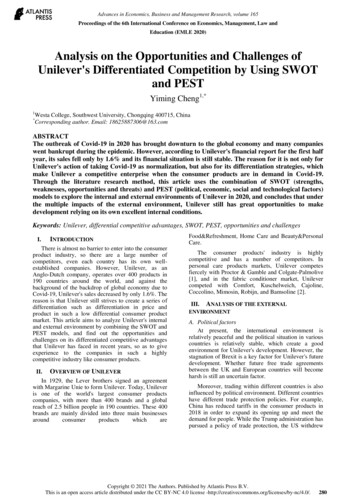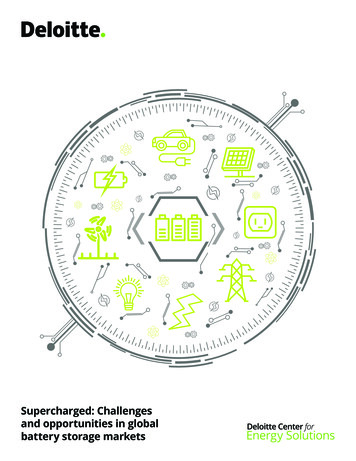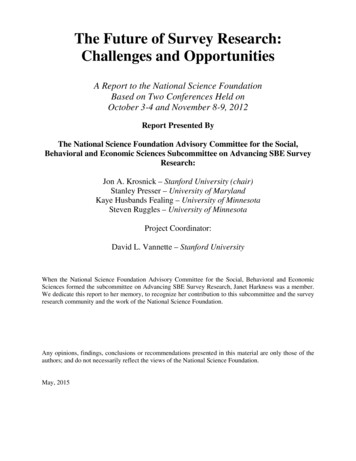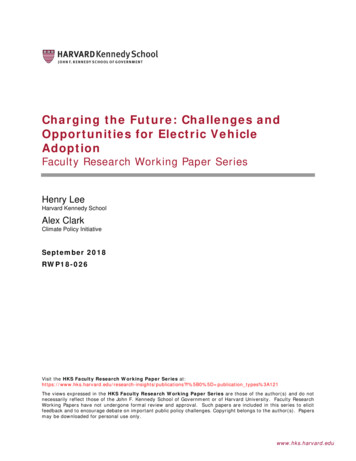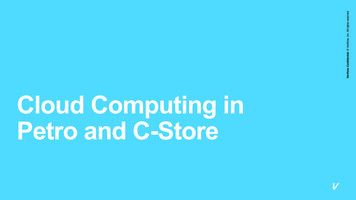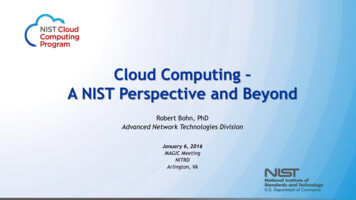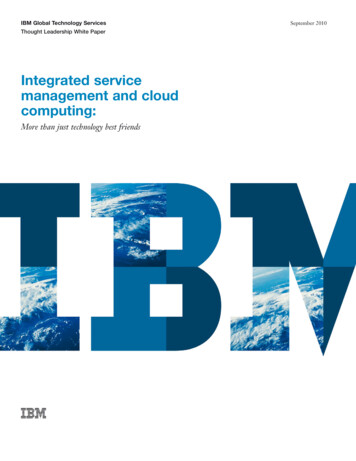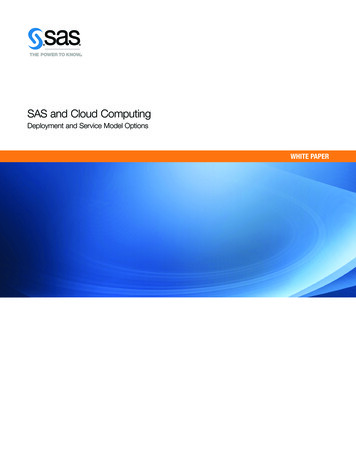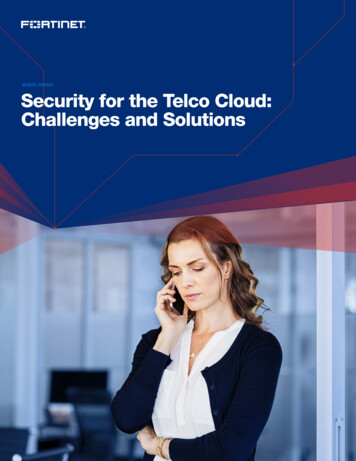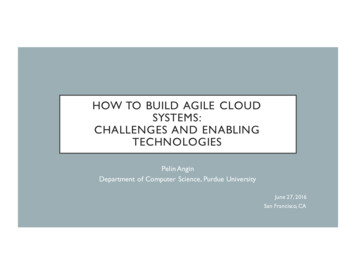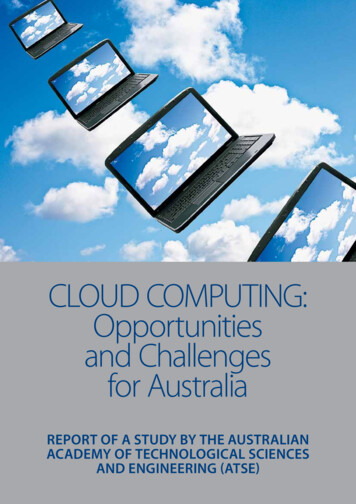
Transcription
CLOUD COMPUTING:Opportunitiesand Challengesfor AustraliaREPORT OF A STUDY BY THE AUSTRALIANACADEMY OF TECHNOLOGICAL SCIENCESAND ENGINEERING (ATSE)
CLOUD COMPUTING:Opportunitiesand Challengesfor AustraliaThis report discusses cloud use by government, businessand universities – both overseas and in Australia – andreveals there are valuable opportunities for Australiain cloud computing: for government, researchers andbusiness. But the Australian Government needs to ensurethat these opportunities are grasped and unnecessarybarriers removed.September 2010
CLOUD COMPUTING: Opportunities and challenges for AustraliaReport of a Study by the Australian Academy of Technological Sciences and Engineering (ATSE) The Australian Academy of Technological Sciences and Engineering (ATSE)ISBN 978 1 921388 15 6This work is copyright. Apart from any use permitted under the Copyright Act 1968, no part of it may be reproduced by any processwithout written permission from the publisher. Requests and inquiries concerning reproduction rights should be directed to thepublisher.PublisherThe Australian Academy of Technological Sciences and Engineering (ATSE)Level 1, 1 Bowen CrescentMelbourne, Victoria 3004GPO Box 4055, Melbourne, Victoria 3004)Telephone 613/03 9864 0900Facsimile 613/03 9864 0930Website www.atse.org.auPrincipal author: Dr J Craig Mudge FTSEThis work is also available as a PDF document on the ATSE website, www.atse.org.auThis project was funded, in part, by CSIRO and National ICT Australia (NICTA)Design and production: Coretext, www.coretext.com.auPrinting: FSG Print Management, www.fsg.com.auDate of Publication: September 2010Cover : iStockphoto
CLOUD COMPUTINGExecutive SummaryCloud computing provides a means of accessing a shared pool of configurable computing resources(including networks, servers, storage applications and services) that can be rapidly provided, used andreleased with minimal effort on the part of users or service providers. There are different types of clouds,ranging from those that are publicly accessible to private clouds with restricted access. These clouds canutilise software, platforms and infrastructure services as needed. The world cloud market is estimated tobe currently worth more than US 20 billion and is expected to grow rapidly.Cloud computing offers important advantages: users pay per use for services and infrastructure, reducing the requirement for capital investment; cloud computing is scalable – when additional resources are needed they can be accessed; cloud computing software facilitates the manipulation of large databases; the increased scale of processors and data storage devices provides economies of scale and energy use;and cloud computing can enable entirely new innovative business services.Governments, businesses and researchers can all benefit from the adoption of cloud computing services.Governments can use the advantages of cloud computing to provide services more efficiently to a broadrange of customers.Governments in other countries are moving quickly to ensure the rapid adoption of cloud computing.In the USA, the Obama administration has launched projects to identify services and solutions that canuse cloud computing. A number of US Government agencies, including the National Aeronautics andSpace Administration (NASA), the General Services Administration and the Department of Defenceare taking initiatives in cloud computing.The UK Government is adopting cloud computing to reduce its administrative costs. Other examplesof the government use of cloud computing range from the census to the management of health servicescontracts. Japan has established a Government cloud to enable various ministries to consolidatehardware and create shared platforms. Sweden, France and Spain are among the leaders in adopting cloudcomputing in Europe.Businesses can develop new services based on cloud computing as well as using the cloud to manage dataintensive activities more efficiently. The major reduction in capital costs that cloud computing providesmakes it attractive to small and medium sized enterprises (SMEs) with limited access to capital.An example of a notable success in the use of cloud computing to create new business opportunities isprovided by Animoto, which enables customers to upload images and music and automatically createscustomised web-based video presentations. Another example, which illustrates the cost-saving potentialof the cloud, is the New York Times’ use of the Amazon Web Service to create an archive of publishedmaterial from 1851 to 1980, accomplished in 24 hours at a cost of only US 240.The Australian Academy of Technological Sciences and Engineering (ATSE)www.atse.org.auMany areas of research are becoming increasingly data-intensive. Cloud computing facilitates theefficient management and use of very large databases. It also greatly reduces the cost of computationwhen segmentation of the task and parallel processing are possible. One example of an application ofcloud computing that offers new possibilities for researchers is in environmental monitoring, wherelarge numbers of sensors can, over time, provide large amounts of data which needs to be collected andi
CLOUD COMPUTINGanalysed. Another example, from India, is the use of the cloud to compare protein sequences in order todetermine evolutionary linkages and predict molecular structures.ConclusionsGovernments have important roles to play in encouraging the adoption of cloud computing andfacilitating the use of cloud-based services by researchers and the business sector. For example, in theUSA, the National Science Foundation (NSF) promotes the use of cloud services by researchers,though a program launched in 2008. Governments in the United Kingdom, Japan and Sweden are alsoencouraging and facilitating the use of cloud computing services by researchers and business.The use of cloud services raises new issues in regard to privacy, security, trust, data transfer capacityand lock-in with service providers. Privacy legislation which pre-dates the development of cloud-basedservices needs to be reviewed. Trust arrangements between service providers and users of cloud servicesmay need new and additional elements to cover all critical interactions. Service providers need to ensurethat data is not lost. Data transfer capacity will need to be enhanced and the cost reduced. These issuescan all be addressed and managed, but some changes to laws and regulations may be required.It will be particularly important for government to protect the interests of consumers and SMEs. Bothshould be able to seek redress for failures on the part of cloud service providers. For SMEs, the cloudoffers exciting opportunities, but they will need government assistance to manage the risks.Network pricing will also be important in determining the adoption of cloud based services in Australia.At present Australia’s broadband prices are significantly higher than the UK – the OECD leader.www.atse.org.auThis report discusses a number of examples of cloud use by government, business and universities – bothoverseas and in Australia, and reveals that this technology has much to offer. While Australia does notyet have the extensive broadband links, large-scale data centres and requisite regulatory environment,these are possible in the near future. There are valuable opportunities for Australia in cloud computing– for government, researchers and business. However, action by the Commonwealth Government isneeded to ensure that these opportunities are grasped and unnecessary barriers removed.iiThe Australian Academy of Technological Sciences and Engineering (ATSE)
CLOUD COMPUTINGRecommendationsRecommendation 1The Commonwealth Government should take a whole-of-government approach to new security andprivacy issues arising from the use of cloud computing, by establishing a new taskforce to review theadequacy of current legislation and identify what steps need to be taken to ensure a supportive regulatoryenvironment.RECOMMENDATION 2The Commonwealth Government’s Commercialisation Australia Program, which assists researchers,entrepreneurs and innovative companies to convert ideas into successful commercial ventures, shouldactively encourage new businesses that are cloud-focused in their internet-scale applications.RECOMMENDATION 3The Commonwealth Department of Broadband Communications and the Digital Economy shouldreview broadband pricing and policies of commercial and other providers to ensure that unnecessaryimpediments to the uptake of Cloud Computing are minimised.RECOMMENDATION 4Australian universities should expand their courses to build knowledge and skills in cloud computing.They should seek the support of cloud service providers to offer short courses for industry, governmentand university researchers on cloud computing, including its data-parallel programming models.RECOMMENDATION 5The Commonwealth Government should create and fund an Australian equivalent of the NSF’s ClusterExploratory Program CluE and the NSF-Microsoft Program to actively encourage the use of cloudcomputing. This could be administered by the Australian Research Council.RECOMMENDATION 6The National Research Infrastructure Council (NRIC) should refine its investment plans to reflect thebenefits that cloud computing can provide.RECOMMENDATION 7The Commonwealth Government should ensure that proposals for research data storage using SuperScience funds have evaluated cloud computing services.www.atse.org.auThe Australian Academy of Technological Sciences and Engineering (ATSE)iii
www.atse.org.auCLOUD COMPUTINGivThe Australian Academy of Technological Sciences and Engineering (ATSE)
CLOUD COMPUTINGAcknowledgementsThe Academy of Technological Science and Engineering (ATSE) is most grateful for the contributionsmade by the principal author of this report, Dr Craig Mudge FTSE, and members of the ATSE SteeringCommittee established to oversee its finalisation (the Steering Committee was formed following thecompletion of a draft Working Group report). Membership of the Steering Committee was: Mr Peter Laver FTSE (Chair); Dr Vaughan Beck FTSE; Dr John Bell FTSE; Professor Michael Manton FTSE; Dr J Craig Mudge FTSE; Dr John O’Callaghan FTSE; and Professor Robin Stanton FTSE.Dr John Bell FTSE contributed to the redrafting and editing of this report and Dr Vaughan Beck FTSE,ATSE’s Executive Director – Technical, was the project manager.ATSE thanks the Working Group formed to prepare a draft report and for inputs received from a varietyof sources during the course of the project. ATSE is also most grateful to CSIRO and NICTA forproviding financial support for the project, which has enabled travel as well as covering a student prize, asubscription to a wiki and other expenses.To obtain more diversity, experts from outside the Academy were invited to join the Working Groupon Cloud Computing at Peta Scale (the Working Group). All members of the Working Group werevolunteers who offered their time, and in some cases, resources from their institutions. The WorkingGroup members were: Dr J Craig Mudge FTSE, (Chair), Pacific Challenge and the University of Adelaide; Professor David Abramson, Monash University; Mr Gordon Bell FTSE, Microsoft Research; Associate Professor Jim Hogan, Queensland University of Technology; Dr Anna Liu, NICTA and the University of NSW; Mr Alan Noble, Google Engineering Director, Australia; Professor Robin Stanton FTSE, Pro-Vice Chancellor, the Australian National University; Dr Andrew Wendelborn, University of Adelaide; Mr Glenn Wightwick, IBM Australia Development Laboratory; Professor Tony Williams, ARCS, Platforms for Collaboration; Dr Darrell Williamson, CSIRO eResearch; Dr John Zic, CSIRO ICT Centre; and Professor Albert Zomaya, the University of Sydney.Working group members from QUT, Monash, and CSIRO hosted 2009-10 summer intern projects.Projects in machine learning for profiling, a cloud-based scanner on a smart phone, and accountability asThe Australian Academy of Technological Sciences and Engineering (ATSE)www.atse.org.auIn addition to regular meetings, some Working Group members undertook several small projectsincluding measuring latency in using overseas clouds, extending ARCS grid capability to includeAmazon’s Elastic Compute Cloud (EC2), trialling an accountability mechanism to improve trust inoutsourced data management, and an eHealth project.One university research laboratory located itssource-code control system SVN in Amazon’s storage service.v
CLOUD COMPUTINGwww.atse.org.aua cloud service were selected through a competition for student project proposals that drew 23 entries.At the end of the summer, the students submitted their results of their projects in a further competition.The winner was Jinhui Yao of Sydney University with a project in an important area of security,“Accountability as a service for the cloud” hosted by CSIRO ICT Centre. These activities of the WorkingGroup informed the understanding, and potential use, of cloud computing for Australia.viThe Australian Academy of Technological Sciences and Engineering (ATSE)
CLOUD COMPUTINGContentsExecutive SummaryiRecommendationsiiiAcknowledgementsv1. INTRODUCTION11.1Project goals and cloud definitions11.2 The definition of cloud computing12. CLOUD COMPUTING: CHARACTERISTICS,APPLICATIONS & BARRIERS32.1Characteristics32.2Cloud service provider features42.3 MapReduce – a new data-parallel programming model62.4 The cloud as a data aggregator72.5Barriers to the uptake of cloud computing93.ROLES AND OPPORTUNITIES FOR GOVERNMENT3.1 The roles of Government in cloud computing4. OPPORTUNITIES FOR BUSINESS1313174.1 Examples of cloud use by business184.2 Opportunities for Australia195. OPPORTUNITIES FOR SUPPORTINGUNIVERSITY RESEARCH235.1 An emerging public-private research infrastructure services sector.235.2 Innovations in data-intensive computing245.3Funding strategy for
cloud computing that offers new possibilities for researchers is in environmental monitoring, where large numbers of sensors can, over time, provide large amounts of data which needs to be collected and . CLOUD COMPUTING ii www.atse.org.au The alian austr academy of Technological sciences and engineering (aTse) analysed. Another example, from India, is the use of the cloud to compare protein .
